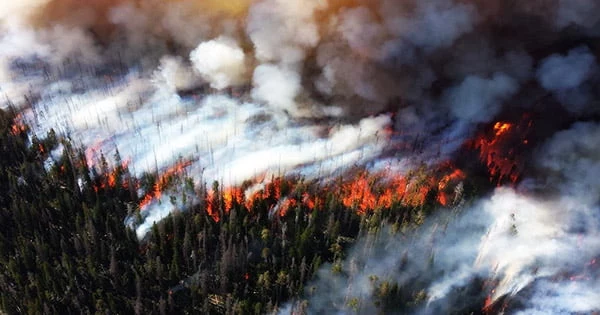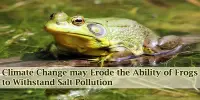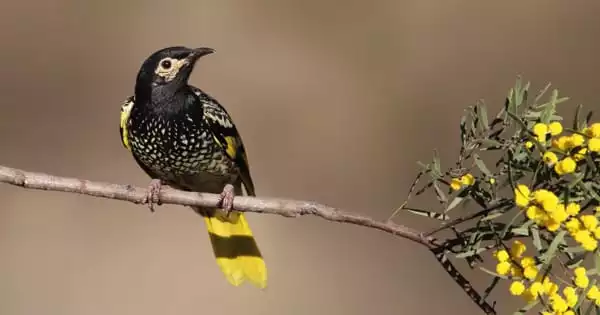Sage and junipers dominate the terrain at Lava Beds National Monument in northern California, with unusual lava caverns snaking under the surface. Wildfires tore through the region in the summers of 2020 and 2021, scorching hundreds of acres and leaving the surface charred.
Temperature, soil moisture, and the existence of trees, bushes, and other potential fuels are all elements that influence wildfire danger. All of these elements are linked to climate fluctuation and change, either directly or indirectly. According to a new study presented at the Geological Society of America’s GSA Connects 2021 annual meeting on Monday in Portland, Oregon, the fires that charred the surface had an influence on life in the caverns below.
Wildfires and volcanic eruptions killed 2400 people globally due to suffocation, injuries, and burns between 1998 and 2017; however the magnitude and frequency of wildfires is increasing due to climate change. Climate change is causing ecosystems to dry out and increase the danger of wildfires.
Healthy caves are delicate ecosystems that support a varied range of tiny animals, birds, insects, and invertebrates in addition to bats. Cave dwellers may be well suited to their niche and so susceptible to environmental changes.

It’s fair to expect the cave ecology to be impacted if a wildfire burns the earth above a cave intensively. Understanding the effects of wildfires, which are hitting more regions every year, has never been more critical.
Around the last year, wildfires have wreaked devastation all over the world. Bushfires in Australia from 2019 to 2020 drew widespread attention, with videos of charred koalas and wallabies making the rounds on social media.
During the early waves of COVID-19, fires erupted in Arizona and Colorado. Boreal woods and tundra fires raged in Siberia’s far north. As autumn approached, Washington and Oregon began to burn, with the resulting smoke and COVID-19 keeping people indoors across the United States and into Canada.
When the Caldwell Fire burned 70 percent of the park in July 2020, scientists at Lava Beds had been studying ecology in 33 caverns for six years. The Antelope Fire, which started in August 2021 and lasted until August 2022, consumed 27 percent of the park’s land.
“So 97% of the park has burned within the past year,” said Jordan Kemp, a Scientists in Parks intern at Lava Beds and graduate student at Indiana State University. The disaster provided a natural opportunity to study the effect wildfires have on cave ecology.
“We’ve never had a fire like this before, so the worry was; Now that we’ve lost all this vegetation at the surface, what will happen to life underneath?” said Kemp.
Cave millipedes, dipluran, and isopods are little invertebrates that have a big influence on cave health: Disturbances at the bottom of the food web can have a cascading effect up the food chain, especially in ecosystems with numerous specialized species. Because lava tube communities in caves are often isolated, unique species that are only present in a few cave habitats might emerge.
Kemp and colleagues returned to the caverns to assess the damage and document species attracted to the tiny baits put for invertebrates in order to answer that issue. The caverns under the Caldwell and Antelope Fires had a considerable loss in ecosystem variety, according to their early findings, which track population shifts and species diversity. Moisture might be to blame for these changes in the neighborhood.
“After the fires, we’ve seen wet caves in burn areas become drier, and some dry caves become wet. Loss of vegetation on the surface could have led to a change in groundwater flow, and how water is percolating down through the soil,” said Kemp.
Cave humidity, an environmental condition to which invertebrates can be particularly sensitive, was influenced by the shift in hydrology. Under fire-affected landscapes, the fundamental relationship between vegetation mediating water flow at the surface and how much moisture gets it into caverns is likely to be true for other caves.
Understanding how fires alter cave moisture and hence variety can aid scientists and land managers in protecting vulnerable cave ecosystems as flames spread over much of the country.
Artifacts and artwork from the Indigenous Modoc people, whose ancestral lands the Monument now occupies, may be found in the caverns in Lava Beds National Monument. Invertebrates can be a helpful signal for preservation concerns to artifacts since they are so sensitive to general cave health.
















